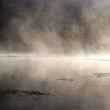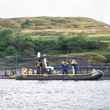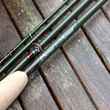Buying a new fly rod should be an enjoyable experience. But my years working in a fly shop suggest much of the time it isn’t. Customers often find the process rather confusing and intimidating, sometimes even downright scary. It’s easy to understand why: An overwhelming number of makes and models crowd the market. Prices range widely, with flagship models fetching around $900.00. Quality varies widely too, but not in clearly defined ways. Marketing campaigns are slick, captivating, hype-laden. Opinions are everywhere too, and cheap. Who and what are we to believe? At the risk of muddying the waters even further, here’s an approach I’ve found helpful.
Begin by knowing why you want a new rod. (Here, it will further the cause if your answer has something to do with fishing.) Perhaps you’d like to address an existing fishing problem. If so, think about the qualities a new rod should possess that solves that problem. Consider writing those qualities down, so they’re well defined. Maybe you’re taking up a new kind of fishing—say, bonefishing or bass bugging. What specific demands will that new fishing place on a rod? Find out, jot them down for reference. Conducting a little research may seem like an obvious step, yet it’s surprising how often it goes overlooked. But buying a fly rod is no different than buying any other tool. Knowing what tasks need performing or what problems need solving inform the decision about what tool to buy. I mean, who buys a chainsaw to whack weeds?
Let’s say you’d like to take up gulper fishing. This is a type of lake fishing for large, free-rising, spooky trout. It’s practiced primarily but not always under calm conditions, casting 35-75 feet with medium to small flies, using 4x-6x tippets. Line manipulation during and after the cast is rarely required. With specific parameters like these in mind, it’s possible to start slicing your way through the jungle of available rods.
In this example, considering the casting distances and the open nature of most lake fishing, a rod of 9 feet in length seems best. The delicacy of a four-weight line seems ideal for spooky fish, but a carefully cast five-weight should work too. A five-weight line carries more energy than a four, aiding distance while also providing a little extra punch should wind become a factor. So let’s opt for a five-weight rod, keeping in mind that it should be a rod whose power is deployed smoothly and efficiently at 50 feet or so, roughly mid-range for this kind of fishing. The light tippets employed here need protecting too—especially at distance. That calls for adequate cushion in the rod’s upper half, something approximating a medium overall flex. Does this rod purchase have budget constraints? Factor them in now. Tally up all these considerations, and you’ll find that the field of potential rods has been winnowed down nicely.
The next step is to cast those rods judged to meet your criteria. (Fishing them is even better.) Either way, focus on your parameters and how the rod addresses them. Comparisons of one rod against another, instead of against the relevant design parameters, can lead to confusion. This advice runs contrary to conventional thinking, I know, where rods are typically evaluated one against one another, or one against many others. But fly rods of a given length and line weight are often designed to do different things, subject as they are to the concerns and philosophies of individual designers. Comparing one 9’ 5-weight to multiple others—under the assumption that they’re all supposed to do exactly the same thing—tends to foster confusion, not clarity. Remember, your goal is to find the rod best suited to the tasks you’ll ask it to perform, and evaluating each rod against the criteria you laid out at the beginning of the process allows you to do just that.
If casting your potential rod choices isn’t a viable option, the next best approach is consulting someone knowledgeable who has. Check with the rod companies themselves. Talk to a trusted fly shop, local or otherwise. Explain your criteria precisely and ask how a given rod stacks up against those criteria.
When your testing is finished, hopefully one rod stands apart in its performance. If that’s the case, great. Buy it. More likely, you’ll have to choose among rods that offer varying compromises in the parameters you identified at the beginning. That’s okay. Just pick the rod that best addresses those parameters, knowing that perfection in fly rods is rarely found. Go forth and fish that new rod with confidence—a confidence born and anchored in knowing you did everything you could to make the wisest rod choice possible.
* Regarding our gulper fishing example, here are four rods that make the cut:
Classic
Leonard Golden Shadow 9′ – 6 weight, 2 pc. A 1970’s rod, one that’s a little difficult to come by today. Though labeled a 6-weight, at gulper distances it performs better with a 5. If you ever see one of these rods for sale, snatch it up.
Contemporary
Sage ZXL 9′ – 5-weight, 2 pc. (The three piece models do not possess the same flex.) This rod isn’t the best for protecting light tippets, but its distance ability is unparalleled among modern rods. Sage stopped making this model a number of years ago, but they can still be found on the internet.
Winston Boron III X 9’—5-weight, 4pc. The upper half of this rod provides good casting efficiency at mid-range gulper fishing distances, and protects fine tippets easily.
Budget
Redington Classic Trout 9’ — 5-weight, 4pc. You can spend three or four times as much for a rod and not get the performance that this rod delivers. A current model, widely available in fly shops.





























Comments